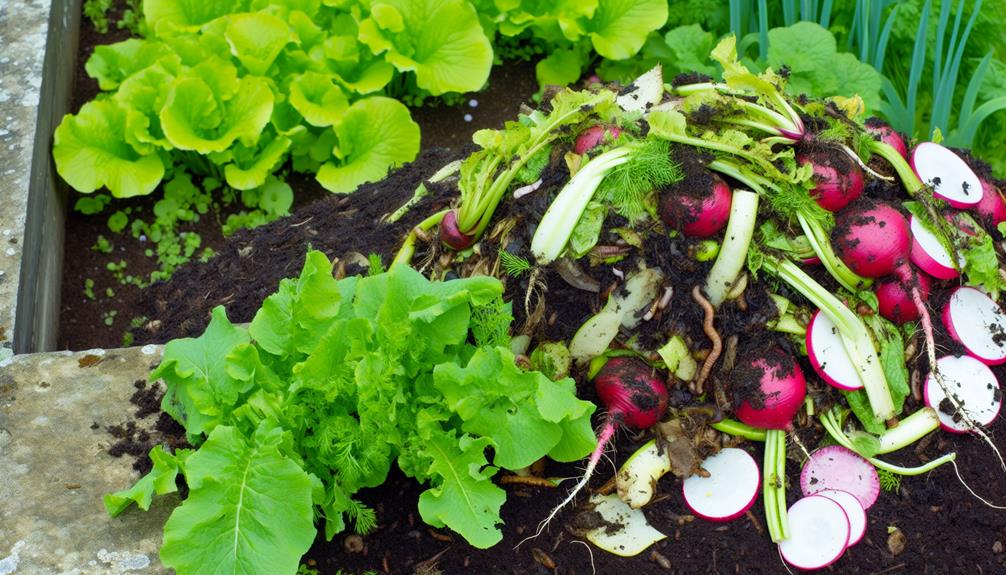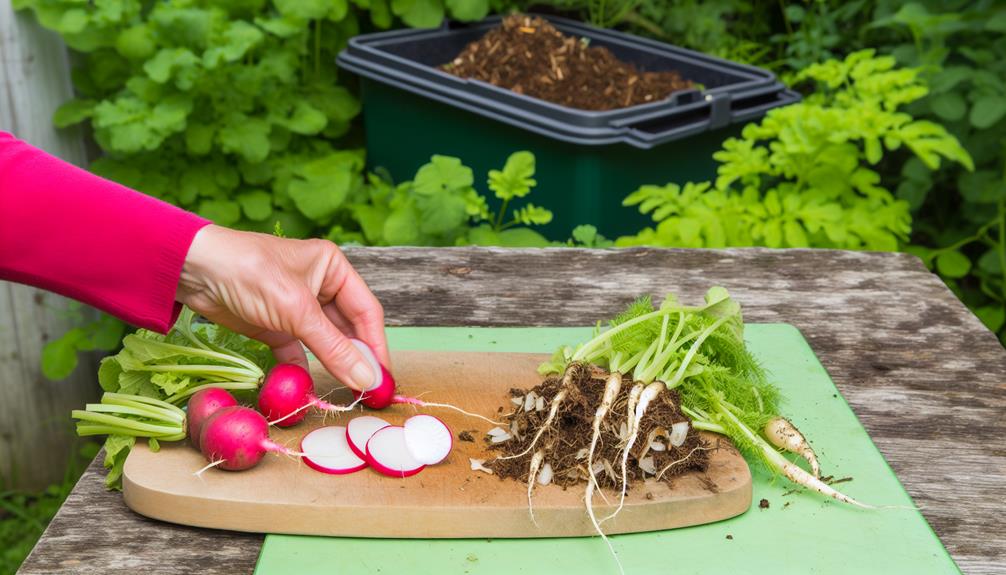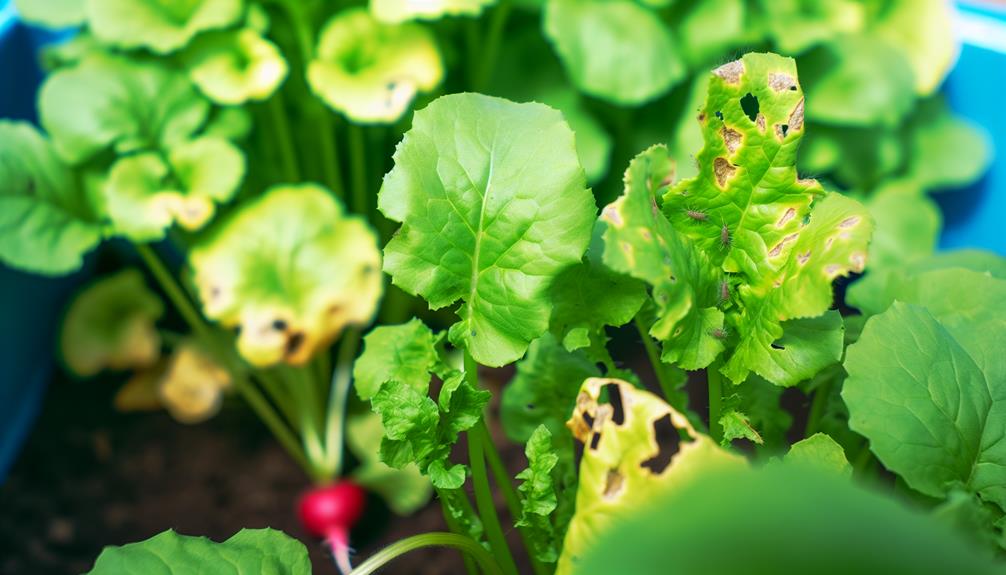

Yes, you can compost radishes to enrich your pile with valuable nutrients like nitrogen, phosphorus, and potassium. Compost radish roots, skins, and tops by washing to remove dirt, then chopping them into smaller pieces. Use green material from radish tops and balance it with brown materials like dried leaves and shredded paper.
Make sure your compost pile is well-drained and turn it regularly for faster decomposition. Be mindful of potential pests and diseases like root maggots and downy mildew. Interested in optimizing your compost with radish waste? Here’s how to get the most out of your composting efforts.
Radishes are packed with essential nutrients that can greatly enrich your compost. When you add radish scraps to your compost pile, you’re not just reducing waste; you’re also boosting the nutrient profile of your compost.
Radishes are rich in nitrogen, phosphorus, and potassium—three key elements that plants need to thrive. These nutrients break down and mix with other compost materials, creating a more balanced and fertile end product.
To maximize the nutrient benefits, chop radish scraps into smaller pieces before adding them to your compost pile. This helps them break down faster, ensuring the nutrients are readily available for your garden.
Additionally, radishes contain organic matter that enhances the compost value by improving soil structure and moisture retention. This means your garden soil will be better equipped to support healthy plant growth.
Also Read: Can You Compost Ice Cream?
Various types of radish waste can be composted to improve your garden’s soil quality. When you’re preparing radishes in the kitchen, you might find yourself discarding radish roots and radish skins. Don’t throw these away; they’re perfect for your compost pile. Radish roots, especially those that are too tough or fibrous to eat, break down well in compost, adding valuable nutrients back to the soil.
Similarly, radish skins are excellent for composting. They decompose quickly and provide essential organic matter. Before you toss them in the compost bin, consider chopping the radish skins into smaller pieces. This speeds up the decomposition process and ensures they integrate well with other compost materials.
Even the radish tops, often removed before cooking, shouldn’t be wasted. They’re rich in nitrogen, making them a fantastic green component for your compost heap. By composting various parts of the radish, you’ll contribute to a richer, more fertile garden.
Also Read: Can You Compost Mail?
To prepare radishes for composting, start by washing off any dirt and debris. Use simple cleaning tools like a brush and water to make sure the radishes are free of soil. Clean radishes decompose more efficiently and help maintain the balance of your compost pile.

Next, chop the radishes into smaller pieces. Smaller pieces break down faster, speeding up the composting process. Use a sharp knife or garden shears for this task. Remember, the goal is to maximize surface area for quicker decomposition.
If you have radish greens, you can compost those too. They’re rich in nitrogen and add valuable nutrients to your compost. Just like the roots, wash and chop the greens before adding them to the pile.
Soil preparation is important for effective composting. Make sure your compost pile is in a well-drained area. This helps prevent waterlogging, which can slow down the decomposition process. Also, consider turning your compost regularly. This aerates the pile and speeds up the breakdown of materials.
Also Read: Can You Compost Carrot Peel?
To create an effective compost pile, you need to balance green materials like radish scraps with brown materials such as dried leaves.
Aim for a ratio of about two parts green to one part brown.
This balance guarantees the compost breaks down properly and doesn’t produce unpleasant odors.
Balancing green and brown materials is crucial for efficient composting, and radish tops make an excellent green material source. Green materials, rich in nitrogen, are necessary to maintain your compost pile active and productive.
When adding green materials, you can also incorporate food scraps and kitchen leftovers. These items provide the necessary moisture and nutrients to accelerate the decomposition process.
Think about all those vegetable peels, coffee grounds, and fruit scraps you generate daily. Adding these along with radish tops creates a well-rounded nitrogen source.
If you’re new to composting, it’s helpful to bear in mind that green materials should be combined with brown materials to uphold the right balance. This balance prevents unpleasant odors and ensures efficient breakdown of compost.
To get started, collect your kitchen leftovers in a small container. Toss in those radish tops, food scraps, and other green materials. Make sure to chop larger pieces into smaller bits to speed up decomposition.
Regularly turning your compost pile and checking its moisture level will also improve the process. By mindfully managing your green material sources, you contribute to a healthier, more vibrant compost pile.
Just as green materials are essential for composting, brown materials like dried leaves, straw, and cardboard provide the necessary carbon to balance the mix. Including these brown materials helps create a rich, nutrient-dense compost. They also improve aeration and prevent your compost pile from becoming too wet and smelly. You can find many suitable brown materials around your home and garden.
Here are some common examples of brown materials:
| Brown Material | Source |
|---|---|
| Fallen leaves | Collected from your yard |
| Dried grass | Leftover from lawn mowing |
| Cardboard | Used boxes and packaging |
When adding fallen leaves, make sure they are dry to avoid excess moisture. Dried grass works wonderfully, but it’s best to use it in moderation to prevent matting. Cardboard, especially from boxes and packaging, should be shredded into small pieces for faster decomposition.
You’ll find that incorporating a variety of brown materials enriches your compost and helps maintain a healthy balance. This will make your composting efforts more successful and rewarding. By using these materials, you’re contributing to a sustainable practice that benefits both your garden and the environment.
Achieving the ideal compost ratios involves mixing roughly three parts brown material with one part green material. This balance guarantees that your compost pile has the right mix of carbon and nitrogen, which are essential for decomposition.
When you’re composting radishes, it’s important to get this ratio right to create a thriving compost environment.
To help you achieve the ideal compost ratios, follow these steps:
Also Read: Can You Compost Carrot Peel?
When composting radish leaves, remember they’re nutrient-rich green matter that can boost your compost pile.

These leaves decompose relatively quickly, so you’ll want to mix them with brown materials like dried leaves or straw to balance moisture and carbon.
This combination helps maintain an effective composting process and prevents your pile from becoming too wet.
Incorporating radish leaves into your compost pile adds a valuable source of nutrient-rich green matter. These leaves are packed with nitrogen, which is essential for soil improvement and plant growth. By adding radish leaves to your compost, you’re creating a more balanced compost mix, which results in richer, healthier soil.
To make the most of composting radish leaves, follow these steps:
Understanding the leaf decomposition rate is crucial to maximizing the benefits of composting radish leaves. Radish leaves are considered green matter, which means they decompose relatively quickly due to their high nitrogen content. This rapid breakdown is advantageous when you’re aiming to create nutrient-rich compost.
To make the most of this process, chop the radish leaves into smaller pieces before adding them to your compost pile. This will speed up decomposition even further.
The mulch benefits of composted radish leaves are substantial. Once broken down, they can be used as an effective mulch to retain soil moisture, suppress weeds, and provide essential nutrients. Additionally, composting radish leaves contributes to soil aeration. As the leaves decompose, they form humus, which improves soil structure and allows air, water, and nutrients to move more freely through the soil.
To ensure that the radish leaves break down efficiently, maintain a balanced compost pile with adequate moisture and regular turning. This practice not only accelerates decomposition but also prevents unpleasant odors.
To optimize composting radish leaves, mix them with brown materials like dried leaves, straw, or paper. Balancing your compost pile with carbon sources and nitrogen-rich items is crucial for efficient decomposition. Radish leaves are considered ‘greens,’ providing nitrogen, while brown materials supply the much-needed carbon.
Here’s how you can achieve an ideal mix:
Mixing these browns with your radish leaves ensures a balanced carbon-to-nitrogen ratio, ideally around 30:1. Regularly turn your compost to maintain oxygen flow and keep it moist but not soggy. By paying attention to these elements, you create a rich, fertile compost that nourishes your garden effectively.
Also Read: Can You Compost Cardboard Tubes?
Radish scraps can greatly enhance the nutrient profile of your compost pile. By incorporating radish leftovers, you improve compost aeration and balance moisture levels. These scraps break down quickly, adding essential nutrients like potassium and vitamin C to your compost. This helps create a richer, more fertile soil for your garden.
To get the most out of your radish scraps, make sure to chop them into smaller pieces. This speeds up decomposition and guarantees even distribution throughout the pile. Mixing them with browns, such as dried leaves or newspaper, helps maintain the correct carbon-to-nitrogen ratio, which is vital for effective composting.
Keep an eye on your moisture levels; radish scraps contain a lot of water, so you might need to adjust by adding more browns if your pile gets too wet. Regularly turning your compost aids in maintaining good aeration, promoting faster decomposition and preventing any foul odors.
Incorporating radish into your composting routine not only enriches your soil but also fosters a more sustainable lifestyle. By doing this, you contribute to a healthier garden and a greener environment, benefiting both you and your community.
Also Read: Can You Compost Cardboard?
While enriching your compost with radish scraps, you should also be mindful of the pests and diseases that commonly affect radish plants. Knowing these issues can help you effectively manage your garden and guarantee that your compost remains healthy.

Radishes are prone to several insect infestations and fungal infections. Here are some common problems you might encounter:
Generally, radish scraps decompose relatively quickly, making them an excellent addition to your compost pile. On average, radish peels and other scraps break down within a few weeks to a couple of months, depending on your composting conditions.
To speed up this process, you need to maintain an ideal compost temperature and moisture level.
First, keep your compost temperature between 135-160°F. This range ensures that the microbial activity needed for decomposition is at its peak. You can achieve and maintain this temperature by regularly turning the compost pile, which adds oxygen and promotes faster breakdown of materials. A compost thermometer can help you monitor and adjust the temperature as needed.
Second, ensure your compost has the right moisture level. It should feel like a wrung-out sponge—moist but not waterlogged. Too much moisture can lead to anaerobic conditions, slowing down decomposition and causing unpleasant odors. Conversely, too little moisture can dry out the pile, halting microbial activity.
Regularly check and adjust the moisture by adding water or dry materials like straw.
Also Read: Can You Compost Cantaloupe?
Once your radish scraps have fully decomposed, you can enrich your garden soil with the nutrient-rich compost. This radish fertilization technique guarantees that your plants receive essential nutrients, enhancing their growth and health.

To maximize the compost benefits, follow these steps:
Yes, you can use radish tops as mulch. They’ll enhance soil fertility and improve moisture retention. Just spread them around your plants, and you’ll help create a thriving, connected garden community.
When composting radishes, make sure the composting temperature stays between 135-160°F for efficient breakdown. Maintain proper aeration by regularly turning the pile. You’ll create a welcoming, nutrient-rich environment for your garden community.
When you compost radishes, you might attract wildlife like rodents and insects. However, practicing good pest control and composting techniques guarantees they won’t disrupt your garden. This helps create balanced wildlife habitats and fosters community harmony.
Yes, you can compost radishes in a worm bin. Just make sure proper radish preparation by cutting them into smaller pieces. This will make it easier for worms to incorporate them into their worm diet efficiently.
Radishes, with their nutrient composition, slightly lower the pH level of compost as they decompose. Their rapid decomposition rate helps balance the mix, fostering a sense of community among your compost materials.
Composting radish waste is simple and beneficial for your garden. Make sure you balance green and brown materials to maintain a healthy compost.
Chop radish leaves and roots into smaller pieces for faster decomposition. Be mindful of any pests or diseases, and monitor the compost’s moisture and temperature.
With these steps, you’ll create nutrient-rich compost that enhances soil health and plant growth. Use your radish-enriched compost to boost your garden’s productivity effectively.
